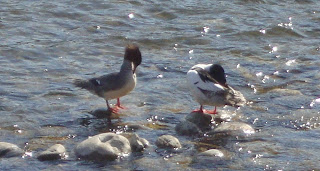Killarney is a residential neighbourhood in the city of Calgary. It is bounded by 17th Avenue S.W. on the north, 37th Street S.W. on the west, Richmond Road S.W. on the south, and 25A Street S.W. on the east.
Killarney es una zona residencial al suroeste de la ciudad de Calgary. Esta delimitada por la avenida 17 al norte, la calle 37 al oeste, la carretera Richmond al sur, y la calle 25A al este.
I took the following photos in December, 2010 / Tomé las siguientes fotos en Diciembre, 2010:
 |
Sunrise in Killarney / Amanecer en Killarney
|
 |
In the morning / Por la mañana
|
 |
| In the afternoon / Por la tarde |
While I was living in this residential area, I really enjoy watching this group of squirrels running and playing around the trees. The squirrel family, Sciuridae, which includes chipmunks, tree squirrels, flying squirrels, marmots, and ground squirrels in Alberta, is considered the most structurally primitive group of rodents. All its members, except the flying squirrels, are active during the day.
Durante los cuatro meses que estuve viviendo en Killarney me diverti mucho viendo correr y jugar a este grupo de ardillas. Ardillas y marmotas forman parte de la familia Sciuridae. Este grupo de pequeños mamíferos es considerado la familia más primitiva de roedores, y la mayor parte de sus miembros, excepto por las ardillas voladoras, están mas activas durante las horas diurnas.
The Eastern Grey Squirrel, Sciurus carolinensis, is also known as "grey" squirrel, even though most of their individuals in the Calgary area are black. This is the classic park and garden squirrel of much of the Western world.
Las Ardilla Oriental Gris, Sciurus carolinensis, también es conocida como ardilla "gris", aunque la mayor parte de sus miembros en la ciudad de Calgary son de color negro. Y es considerada la clasica ardilla de parque y jardin en el mundo Occidental.
 |
Breeding occurs from December to February /
La reproducción tiene lugar entre Diciembre y Febrero
|
|
Grey squirrels on the tree / Ardillas grises en el árbol
|
This specie of squirrel den in trees. They build nests lined with dry vegetation in natural tree cavities or in old woodpecker holes. However, if there are not cavities available, they build dreys, which are spherical leaf and twig nests in tree branches.
Esta especie de ardillas hace su nido en los huecos de los arboles utilizando vegetación seca, pero sino hay ningún hueco disponible, lo harán en la rama del arboles.
These true nut-lovers feed mainly on the seeds of different kind of trees which they usually bury during the summer. However, they also eat buds, flowers, leaves, an occasionally animal matter, such as eggs or nestling birds.
Estos amantes de los frutos secos y semillas de arboles también se alimenta de flores, brotes tiernos, hojas, y ocasionalmente huevos y polluelos. Normalmente van a almacenar las semillas que recolectan en verano para alimentarse en invierno.
 |
Photo took from the basement /
Tome esta foto desde el sótano de la casa
|
 |
Grey squirrel taking an almond /
Ardilla gris cogiendo una almendra
|
 |
Grey squirrel and domestic pigeon /
Ardilla gris y paloma doméstica
|
 |
Foreprint and hindprint in the snow /
Huella delantera y trasera en la nieve
|
 |
| Hindprint / Huella trasera |
I hope you like it!

























































